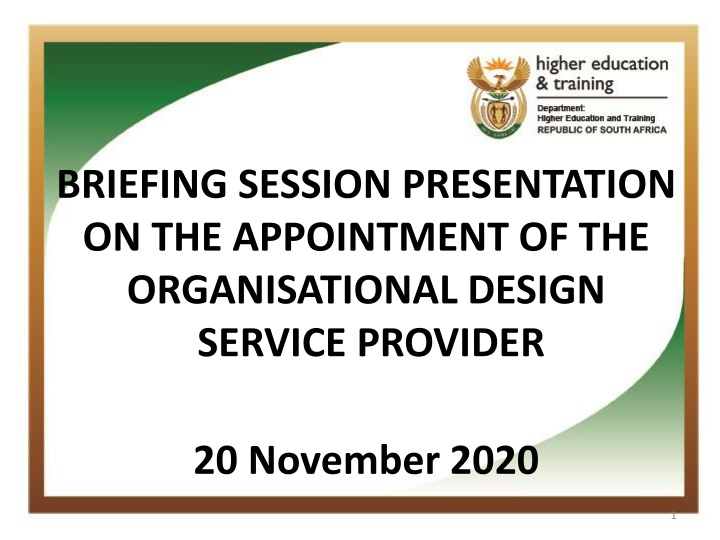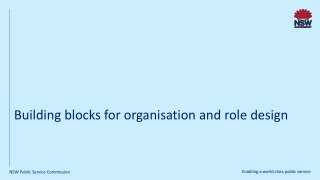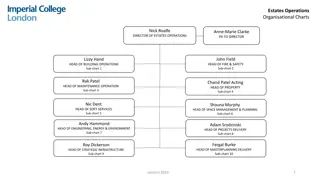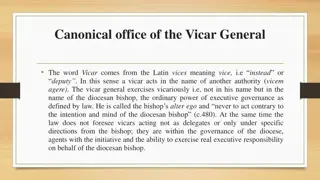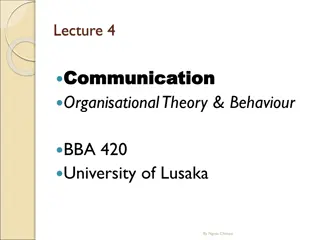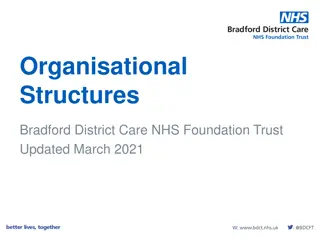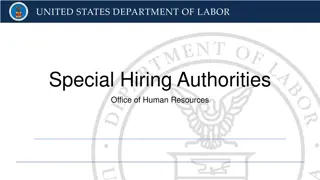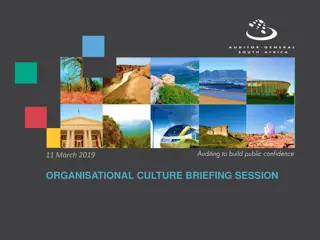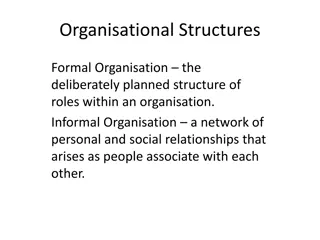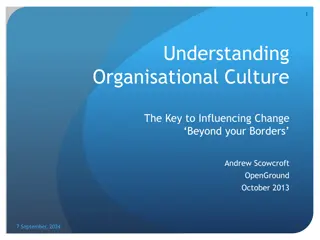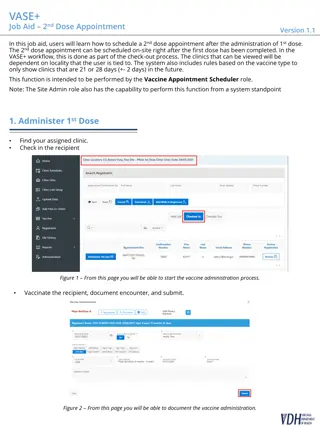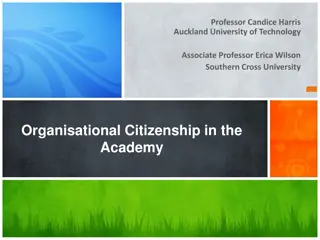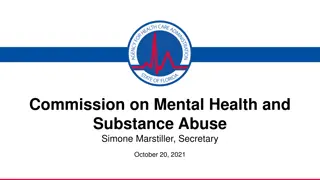Update on Organisational Design Service Provider Appointment
The presentation covers the background, important factors, scope of work, deliverables, and required qualifications for appointing an organisational design service provider for the Department of Higher Education and Training. It discusses the department's establishment, current interim structure, need for a new organisational design, and recent developments impacting the design review process.
Uploaded on Sep 08, 2024 | 1 Views
Download Presentation

Please find below an Image/Link to download the presentation.
The content on the website is provided AS IS for your information and personal use only. It may not be sold, licensed, or shared on other websites without obtaining consent from the author.If you encounter any issues during the download, it is possible that the publisher has removed the file from their server.
You are allowed to download the files provided on this website for personal or commercial use, subject to the condition that they are used lawfully. All files are the property of their respective owners.
The content on the website is provided AS IS for your information and personal use only. It may not be sold, licensed, or shared on other websites without obtaining consent from the author.
E N D
Presentation Transcript
BRIEFING SESSION PRESENTATION ON THE APPOINTMENT OF THE ORGANISATIONAL DESIGN SERVICE PROVIDER 20 November 2020 1
PRESENTATION OUTLINE Background; Important factors; Scope and definition of work; Deliverables; and Appropriate qualifications, experience, skills and knowledge 2
BACKGROUND The Department of Higher Education and Training was established in 2010 through a Presidential Act of 11 May 2009 and in terms of Proclamation No.48, 7 July 2009. The President transferred the administration of the specific sections of the Skills Development Act with the powers and functions entrusted by the said legislation from the Minister of Labour to the Minister of Higher Education and Training through a proclamation published in a Government Gazette no. 32549 of 04 September 2009. The Department of Education was then split into two new departments, that of Basic Education and Higher Education and Training and the skills development some functions of the Department of Labour also transferred to the newly established Department of Higher Education and Training. The Department has, since 01 April 2010, been operating on an interim organizational structure until March 2019 when the Minister approved an interim organizational structure with the concurrence of the Minister for Public Service and Administration as required by the Public Service Act of 2007. There is however an organizational design that was approved in 2014 but it could not be concurred with by the Minister for Public Service and Administration as it was not fully funded. 3
BACKGROUND Cont. The Department is currently operating on an interim organizational structure which is not aligned to the vision of the 6th administration and the 2020-2025 Strategic Plan of the Department. Regulations 25 (2) of the Public Service Regulations requires that the executing authority shall, based on the strategic plan of the department: a. determine after consultation with the Minister the department s organizational structure in terms of its core and support function; b. define the posts necessary to perform the relevant functions while remaining within the budget and medium-term expenditure framework of the department, and the posts so defined shall constitute the department s approved establishment; C. grade proposed new jobs according to the job evaluation and job grading systems referred to in regulation 41(1), except where the grade of a job has been determined in terms of an OSD or directed by the Minister in terms of regulation 41(2)(d); and d) engage in human resource planning in accordance with regulation 26 to meet the resulting human resource needs. 4
BACKGROUND Cont. There has been significant developments since the 2014 structure was finalized which requires a review of the current organisational design. These include amongst others: (i) the transfer of the Technical and Vocational Education and Training (TVET) and Community Education and Training (CET) Colleges into the Department in 2015; (ii) the White Paper on Post School Education and Training and the National Plan of the White Paper; (iii) the new SETA landscape; (iv) the changes of the Administration from the fourth to the sixth, (the interim structure was approved towards the end of the fifth administration); (v) the creation of a single Ministry of Higher Education, Science and Innovation, that includes the Department of Higher Education and Training and the Department of Science and Innovation; which requires rationalisation of the Service Delivery Model given the strategic similarities/functional relations; and (vi) the new Strategic Plan from 2020-2025. The developments outlined above have a major impact on the service delivery model and human resource needs of the department that would enable the achievement of the new priorities and mandate. The new Ministry has a broader mandate with a possible overlap on some functions between the two departments. 5
IMPORTANT FACTORS TO CONSIDER DURING THE REVIEW Amongst the issues highlighted in the above slide, the following factors should be taken into consideration during the review process: The current interim organizational structure, still has some resemblance of the previous Departments of Education and Labour as some branches were simply transferred to the DHET as they were, resulting in some disparate and misalignment with the new vision of the DHET. For instance, the skills planning function is not well defined and is scantily resourced even though skills planning is one of the key mandates of the Department. There is no integration of skills planning within the department as the Sector Education and Training Authorities (SETAs) still perform their own skills planning, compromising the ability of the department to plan holistically and have a comprehensive and integrated plan. Infrastructure development is another key strategic programme that needs some rethink and a level of synchronization and integration for a post school education and training infrastructure delivery programme. 6
IMPORTANT FACTORS TO CONSIDER DURING THE REVIEW Cont. The Department has established six Regional Offices as an interim measure mainly informed by the available budget. There has not been a thorough analysis of how the regions could enhance and support colleges and be a strategic link between the Department and provincial and local government. The Regional Offices were introduced as a pilot to establish DHET footprints with the transferred posts from provincial departments. The Regional Offices remain lean and trim, the intention has not been to create an administrative layer but to focus on core service delivery; concurrence with MPSA obtained. The clustering of the North West and Mpumalanga; Gauteng and Free State; and Western Cape and Northern Cape provinces into one region, is proving to be cumbersome to manage. 7
IMPORTANT FACTORS TO CONSIDER DURING THE REVIEW Cont In 2015 the Minister decided to split the Vocational and Continuing Education and Training (VCET) into two branches through a simple splitting of the functions. A proper review and analysis of the effectiveness of the split is necessary as the two types of colleges are informed by one piece of legislation and there is room for an alignment as the two types of colleges are serving the same segment of the population at times with the same needs but in different forms of delivery. Some TVET colleges have established skills centres that offer skills programmes that in some countries are community based and driven at local level. On the other hand, in some countries TVET colleges would offer programmes that seamlessly articulate to higher education programmes, offering a broad set of vocational programmes. It is expected that the re-organisation will promote the efficient, economic and effective use of resources in order to improve the functioning of the Department. The intention of this will be to maximize efficiencies and coherence across the integrated post-school system, to eliminate any duplication of functions, both vertically and horizontally and to ensure continuity in the post school education and training value chain. 8
IMPORTANT FACTORS TO CONSIDER DURING THE REVIEW Cont TVET colleges are geographically dispersed with some having campuses in rural areas whilst others are highly urbanised and situated in industrial and economic hubs of the country. They vary in size and programme offerings with different needs and skills sets. Also, the management of these institutions has varying demands and that suggests a graded system or approach of resourcing and management. The review process could also look at what is the best-fit management approach that ensures development, growth and sustainability. The biggest challenge for the department with these colleges is around management capacity and governance in one form or another throughout the college sector. Governance, monitoring and evaluation of institutions is decentralised within branches due to different pieces of legislation informing governance systems. Whilst it is acknowledged that legislation informs the nature of governance systems and interventions, there is a need for a clearly defined governance, monitoring and evaluation model with increased capacity within the department. 9
IMPORTANT FACTORS TO CONSIDER DURING THE REVIEW Cont Although the review should be focused on the re-organisation of the Department, business process re-engineering (BPR) should give due consideration to the changing role of a colleges with concomitant structural misalignment that compromises the department s ability to realize its objective of a college system that responds to skills needs and development vis-a-vis an economic growth trajectory. There was a turn-around plan for colleges, five years ago but its thrust might have lost relevance due to the new strategic and priority imperatives such as bringing colleges closer to industry through partnerships and the role that SETAs must play. Therefore this review process could play a catalytic role for the development of a streamlined and mainstreamed business model. The majority of employees of the Department are based in colleges, with a total of 18 000 at TVET colleges and 13 000 in Community Education and Training Colleges. Each college has its own corporate services and finance division whilst their employees are part of the establishment of the department employed by the Minister. Colleges Councils also appoints own employees with separate payroll systems. In 2020, the department will be implementing Post Provisioning Norms (PPN) and distribution model that seeks to assist in the planning, distribution of human resources to colleges and organisational structures for colleges. This review could look at how best could the Department have a synchronized system of capacitating regional offices and colleges management layer with a clearly defined system of delegation of authority. 10
IMPORTANT FACTORS TO CONSIDER DURING THE REVIEW Cont At an operational level, duplication and misalignment is nuanced in different forms; for instance INDLELA still has its own human resource management division that is not part of the Corporate Services Branch, there are functions that are performed within the National Examinations and Assessment that should be performed with the Human Resource Management Chief Directorate and Finance branch. In the context of a constrained economic environment, alternative ways of providing support services in a shared services model could be worth exploring. It is therefore expected that a holistic approach to organizational development will be pursued including job profiling and matching, business process mapping, systems development and change management. A total of 1800 funded posts have been provided for on the staff establishment of the Department of Higher Education and Training over the medium term. This includes head office, regional offices and some staff at district level who are supporting community learning centres (CLCs). The district based staff are not supported by the current interim regional office structure and the chain of command with CET colleges is not clearly defined. There has not been an intention to have district level capacity for the Department as CET colleges are responsible for the employment of staff at college level. 11
IMPORTANT FACTORS TO CONSIDER DURING THE REVIEW Cont It must be acknowledged that a change process of this magnitude requires a concerted effort in ensuring that the process minimises the negative impact and minimises possible casualties. Part of the process therefore is to drive a change management and staff engagement process to secure employees ownership of the process. Most organizational review processes would impact on the sense of security of employees and that must be mitigated through a proper change management and employee engagement strategy TVET colleges are geographically dispersed with some having campuses in rural areas whilst others are highly urbanised and situated in industrial and economic hubs of the country. They vary in size and programme offerings with different needs and skills sets. Also, the management of these institutions has varying demands and that suggests a graded system or approach of resourcing and management. The review process could also look at what is the best-fit management approach that ensures development, growth and sustainability. The biggest challenge for the department with these colleges is around management capacity and governance in one form or another throughout the college sector. Governance, monitoring and evaluation of institutions is decentralised within branches due to different pieces of legislation informing governance systems. Whilst it is acknowledged that legislation informs the nature of governance systems and interventions, there is a need for a clearly defined governance, monitoring and evaluation model with increased capacity within the department. 12
SCOPE AND DEFINITION OF WORK The appointed service providers will conduct the organisational structure review in line with the following critical phases as outlined in the DPSA Guide and toolkit: Phase 4: Determine staff requirement Phase 2: Determine Requirements Phase 1: Diagnose Phase 3: Design Phase 5: Plan Phase 6: Implementation Determine requirements & capabilities for success; Implementation of the Operational Management Framework (OMF); Define the Service Delivery Model (SDM); and Business process mapping. Diagnose problem/ opportunity; Understand business drivers & current performance; Identify & define problem/ opportunity; Determine organisational context; Analyse current performance; Identify root cause(s) of the problem; Initiate change Determine staff establishment requirements and costing thereof. Develop business case & implementation plan for the future organisational structure; Completion of all required documentation for consultation with National Treasury for confirmation of funds and MPSA for concurrence of the reviewed structure Obtain assurance letter from CFO for confirmation of funds; Completion of implementation plans and required documentations Assist with the desktop matching and Placement of officials; Skills transfer to Organisational Development and Change management officials. Arrange a consultation meeting with relevant stakeholders to review the proposed structure for the department in alignment with the strategic plan, SDM and White paper on post-school education and training system; Develop/review job descriptions; Conduct job evaluations; and Costing of the final proposed structure and confirmation of funds with Office of the Chief Financial Officer (CFO). management processes; and Develop the case for restructuring. 13
DELIVERABLES The services of an organizational development expert are required to perform the following deliverables: 1ST DELIVERABLES Develop a project plan for the review process; Analyse the legislative mandates and strategy analysis of the Department; Develop a Service Delivery Model aligned to the strategic objectives; Development of the organizational matrix; Identification and definition of the high to low level functions of the department; Alignment with the strategic plan 2020-2025, Medium Term Strategic Framework (MTSF) and the Minister s Performance Agreement with the President; Alignment and articulation with the National Plan for the implementation of the White Paper on post- school education and training system; Develop a model for DHET regional presence; Design of the organizational structure and its costing thereof Development of a business case in line with the template provided for by the DPSA; and Development of an implementation plan/ Migration plan. 14
DELIVERABLES Cont. 2ND DELIVERABLES Assist in the development of job profiles and descriptions; Assist in conducting job evaluation of all posts in the establishment; and Provide assistance in the placement of staff against the new organizational structure. 3RD DELIVERABLES Implement change management programme; Assist in developing service delivery improvement plan for the department; Assist in aligning the HR Plan with the organizational development and service delivery improvement plan; and Develop a monitoring and evaluation framework. 15
APPROPRIATE QUALIFICATIONS, EXPERIENCE, SKILLS AND KNOWLEDGE The organisational design service provider/team of experts must have: Honours Degree (Team Leader) and Bachelor s Degree(Team Members) in Management Services/ Human Resource Management / Organisational Industrial Psychology; Proven Organisational Development/Design and Change Management experience of 5-10 years of working experience within government at all levels; Demonstrable experience in managing complex organizational review process and having expertise in translating organizational strategies into organizational design; It must have business process re-engineering and organizational management framework expertise; It must have extensive knowledge in developing job profile and conducting job evaluation; and Must have knowledge in utilise Orgplus system, Equate and evaluate job evaluation systems. 16
